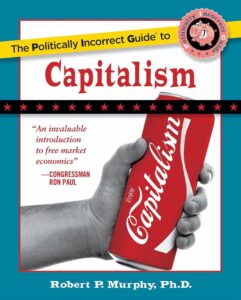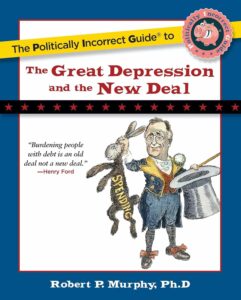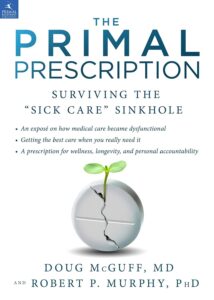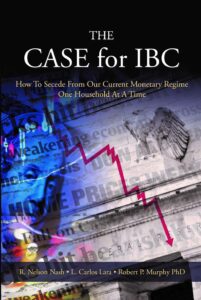China Stimulus Versus US Stimulus
In an earlier post, I remarked on Brad DeLong’s failure to reflect on the (reported) fact that China has booming economic growth even as its consumer prices are falling. Instead of dealing with that problem (since it is rather inconvenient for those warning about a deflationary trap), DeLong simply titled his post, “China’s Larger Stimulus Program Appears to Be Working.”
At first, I thought DeLong’s title meant, “China’s stimulus program is bigger than the US stimulus program, and that’s why its economy is booming.” As we’ll see below, that theory doesn’t work, because the US deficit is much bigger (even as a share of the economy) than China’s. Another interpretation is that DeLong simply meant, “Now that the Chinese have bumped up their spending, their economy is doing better.” If that’s what he means, OK, but then it’s still odd that with such a punitive (by Keynesian rhetorical standards) deficit, they are having a booming economy.
I didn’t research it too much, but this Reuters story (from back in February) says that the Chinese government’s budget deficit was projected to be about 3% of GDP in 2009.
For comparison, the US budget deficit in FY2009 is projected to be more than 13% of GDP. And for what it’s worth, the US budget deficit in FY1933–this was when the stupid Hoover foolishly tried to balance the budget, much to the chagrin of Krugman–was 4.5% of GDP. So I’m not seeing how the Chinese right now are engaging in more aggressive Keynesianism than Obama & Friends; they’re not even pumping up Aggregate Demand as much as Hoover did right at the time when Krugman scolded him for dooming the economy.
(And note that DeLong can’t say, “Sure China’s overall budget deficit is lower, but their stimulus package is bigger.” Because we all know the object of the spending is irrelevant as far as Aggregate Demand goes. That’s why Keynes said burying bottles of money would work, and remember when President Obama said, in reference to his Republican critics complaining about spending, “Whaddya think a stimulus is?!”)
Explain please, Prof. DeLong.
Krugman Tri-blechta
I told Jeff Tucker (editor of Mises.org) that I would lay off Krugman for a while, since I don’t want the Austrians to be the Party of No. But I didn’t make any promises about Free Advice. Today Krugman has three contiguous blog posts that really set me off.
In this one Krugman says “Matthew Yglesias marvels at the extent to which stagflation in the 1970s — which was bad, but not remotely as bad as the Depression — was used to sell the idea Keynes bad, free markets good.” That’s right Prof. Krugman. The old-school Keynesian model said that you can’t have rising prices with excess capacity; you said it yourself earlier this year. (Update: Krugman actually didn’t mention excess capacity in this piece saying we have no inflation risk right now.) So stagflation is impossible, according to classic Keynesianism. Thus the observed stagflation of the 1970s blew up the theory. QED. (I’m sure Krugman would give some story that it wasn’t increased Aggregate Demand, but rather falling Aggregate Supply, causing the inflation. But then why is he blaming monetary policy in the latest post?) There was no liquidity trap in the 1970s; interest rates weren’t zero. So again, how does a Keynesian explain zooming prices amidst excess capacity?
Now on to post #2, which really got me going. Krugman takes a pompous swipe at Bryan Caplan–hey, that’s my job! Caplan is such a dumb economist, he actually thought raising the price of something would reduce the quantity demanded. Naturally this earned Caplan an “Um” from the laureate. And for good measure, at the end of the post Krugman said, “What’s striking here is the cynicism. Feldstein, in particular, is surely a good enough economist to know better. But he and Caplan and others are prepared to grab any argument they can to block progressive reform.” So not only is Caplan an idiot, but he’s such a bad economist that Krugman doesn’t really expect anything better from him; hating sick people is par for the course for such a lightweight.
The funny thing is, if you click through and read the post, part of Krugman’s (echoing Kevin Drum) complaint is that Capan and Feldstein are counting the negative impacts of the health care “reform” and Waxman-Markey bill, when those plans won’t kick in until after the recession. That’s what makes Caplan and Feldstein such liars (and/or morons); they are saying “at a time like this” we can’t raise labor costs. But at the end of April, Krugman had no problem saying the climate bill would help pull us out of the recession (because it would force businesses to invest on carbon-free techniques). So I guess businesses are forward-looking when it comes to capital costs, but not to labor costs. Presumably Feldstein (the good economist) learned that at his school, but Bryan and I missed that subtlety.
Finally, in this post Krugman says that the AMA has “played a consistently nefarious role” in health care reform. He notes that the AMA has endorsed the House plan, and then proceeds to rip the WSJ. So, does that mean the House health plan is nefarious? I don’t think that’s what Krugman is trying to say. But if it’s not nefarious, then the AMA’s endorsement of it means they aren’t nefarious anymore. So why then is their earlier (nefarious) history relevant? (Update #2: Upon further review, maybe Krugman is just being goofy in this post. He did rip the WSJ, but now I don’t think that was the main point.)
Another Krugman Non Sequitur, This One on Health Care
Look at this:
A trivial but telling example
Example of what? Of the absurdity of the US health care system.
Today’s mail brought a letter from Princeton: all faculty members must supply copies of their marriage licenses and of their 2008 tax forms if they want to have their spouses continue to receive health benefits. I don’t know exactly what that’s about — are there a significant number of my colleagues just pretending to be married?
We’ve checked — we don’t know where our marriage certificate is. We’ve already sent to California for a copy — but given the state of that state, God knows when or whether it will actually be delivered.
I assume the university has some good reason for doing this; but from a social point of view it’s just bizarre.
Now he doesn’t say it in this particular post, but obviously Krugman is telling us our health care system is screwed up, and so the government needs to fix it.
So, does Krugman seriously believe that stupid pointless form-filling-out is going to go down when the government gets more involved in health care?
And let’s look at the specific reason this is such a chafe for him. The government record keepers in the most “progressive” state in the country can’t be bothered to send him the form he needs.
Far from justifying bigger government in health care, Krugman’s anecdote–to the extent that it has any relevance–shows the opposite.
Believing Is Seeing, Economics History Edition
Tom Woods defends his honor against what was apparently a hit piece in Liberty magazine. Bruce Ramsey was reviewing Woods’ book Meltdown, as well as a book by two other authors, and wrote: “You immerse yourself in the facts, see what the connections are, and let the story itself tell you what the explanation is. This is what Muolo and Padilla try to do. It is what many libertarians ought to learn how to do.” Ramsey’s point was that Woods–an ideological libertarian–came on the scene already knowing “the government did it” and just found the facts that suited his preconceptions.
Tom does a good job rebutting that charge, as you can see if you click the link. Part of the response involves a point that we learned from Mises: you can’t look at history and let the facts speak for themselves. (As I said in an earlier article, if you try that, your biases will end up doing the talking.) The very act of choosing the facts to inspect is guided by your theories of the subject in question. To give a silly but perfect example: If we want to explain the housing boom, why not pore over NASA records regarding Neptune’s orbit from 2002-2006? Those are facts of that period. I sure hope you don’t walk into this project already “knowing” that Neptune had nothing to do with it, crank!
Anyway, on Brad DeLong’s blog today I spotted a good example of this. He links to this FT article on China’s economic growth, and Brad excerpts the following:
China’s economy accelerated significantly in the second quarter, with gross domestic product expanding by 7.9 per cent, ahead of analysts’ consensus estimates. Li Xiaochao, a spokesman for the National Bureau of Statistics, said the economy “had stabilised with increasing positive changes”, as the new data were announced on Thursday. The surge in growth was driven by the government’s aggressively loose fiscal and monetary policies, introduced late last year, with most of the funding coming from record lending by state banks.
The economy grew by 6.1 per cent in the first quarter, leading many China economists to believe that the government would not be able to meet its year-long growth target of 8 per cent. But the government’s pump-priming has turned the economy around, prompting rapid revisions by many investment bank economists, and the World Bank, to upgrade China’s outlook. Mr Li said that fixed asset investment rose strongly, up 33.5 per cent in the first half of the year compared to the same period in 2008.
Inflation, the Chinese government’s biggest policy headache until the middle of last year, remained under control, with the consumer price index falling by 1.1 per cent in the first half of the year and 1.7 per cent in June alone. Many local economists believe that the central government will not begin to rein in the stimulus programme until inflation begins to pick up, or at least turns positive…
Now just look at that last paragraph again. Doesn’t that strike you as a bit odd? I thought the very very worst thing in the world, was to get caught in a deflationary spiral. The Chinese CPI reportedly fell 1.7 percent in June alone, and it’s down 1.1 percent over the first two quarters of 2009. Haven’t we had it beaten into our heads that Asians and deflation don’t mix? And yet, real GDP reportedly grew at a 7.9% rate in the 2nd quarter. (Note that I keep saying “reportedly” because I have no idea how much credence to give these numbers. I don’t trust the BLS figures for the US, so I am extremely skeptical about what nominally communist ministries tell us.)
So does DeLong come up with some convoluted story as to why deflation isn’t such a big deal after all? Nope, he ignores that part of the story completely. He offers no commentary except the headline: “China’s Larger Stimulus Program Appears to Be Working”
"Hmm, the Russian president is showing the press a new global currency? That’s kind of frighten–LOOK! BOOBIES!!"
Now kids, I realize some of you may think I’ve gone off the deep end lately. But let’s suppose for the sake of argument that we really are getting close to some major financial action, and that the elite need to keep everybody distracted RIGHT NOW. So you’ve got the Michael Jackson stuff, which–come on–is talking up a ridiculous amount of coverage.
And oh yeah, for a few days now CNBC has been pushing pornography. (It’s both the big ads and the “news” stories.) Doesn’t that seem a bit odd?
Another Month, Another Big Price Spike, Another Seasonal Adjustment Downward
And the beat goes on. Two days after having a bunch of fair weather friends tell me, “Normally I love your stuff Bob, but Mish is right–we can’t have inflation until the deleveraging is complete,” the media tells us “Inflation Remains Tame” even though prices went up 0.7% from May to June. (Since when is an 8.7% annualized inflation rate “tame”??) Of course, the real number was 0.9%, and they seasonally adjusted away 20 bps. A few observations:
* Now the grace period is over. Every single month this year, the BLS has reported a lower inflation number than the actual increase in the CPI. Now that in and of itself isn’t sinister, so long as they now overreport the numbers from July through December. (That’s the whole rationale of seasonal adjustment, that prices tend to rise in the first half of the year, and so the BLS spreads it around more evenly among the months so as not to give a misleading impression in the early months when prices shoot up.) But since the desire is to keep inflation expectations low–among other things, it allows Bernanke to continue with his insane policies–I predict that they won’t bump up the actual numbers in a symmetrical fashion in the coming months. Rather, they will revise the adjustments from the first half of this year, saying, “Oh, we actually did have real inflation back in the first two quarters. So now we’ll book the price rises to those previous months, meaning that the price rise of 1.2 percent in September is real; we don’t need to bump it up to a seasonally adjusted 1.6 percent hike.”
* For those who don’t know how to do exponentiation, the actual 0.9% price hike from May to June corresponds to an annualized price inflation rate of 11.4%. I’m not sure how that’s possible, because everybody from Paul Krugman to the Austrians who email me, assures me you can’t have inflation when there’s “excess capacity” in the system. Why, just this morning even our beloved Robert Wenzel wrote in a post that hyperinflation and depression were on opposite ends of a spectrum. (I think it was a brief lapse for the great Wenzel; earlier he has been good by pointing out that Zimbabwe shows you can get big unemployment and big inflation at the same time.)
* Of course, you can’t cherry pick a single month. Rather than looking at just what happened from May to June, let’s go from Dec 08–when prices bottomed out–to June 09. That is half a year, kids, so surely that’s a decent length of time for the trends to assert themselves. This is no mere blip. And during this six-month interval, when “right wingers” like Mankiw and left wingers like Krugman are telling us we need to fear a deflationary black hole, the actual, unadjusted CPI rose 2.6%, translating into an annualized price inflation rate of 5.3%. Can someone remind me what Bernanke’s “comfort zone” is on inflation? I’m pretty sure 5.3% inflation is way way above it. At what point is he going to start sucking reserves out?
* For those who like pictures, try this:

So what’s my explanation of the above? Simple. Because of the panic that began in September 2008, everybody wanted to hold more cash. Bernanke accommodated them by expanding M1 at double digit rates. However, the demand for cash outstripped even this huge growth in supply, and prices had to fall a few points to restore equilibrium. But this process ended back in December. Since then, we are back on the normal inflationary path. The kicker is, banks have an obscene amount of excess reserves. Once people besides me (and a few others who “don’t get deleveraging”) realize that our future portends INflation, not deflation, banks are going to get those reserves into something that yields more than 0.25% (or whatever rate Big Ben is paying them). And then you’re going to wish you had more gold and silver coins under your bed.
* Last point: In fairness, the humongous 0.9% jump in prices last month was not across the board; it was focused in energy and a few other sectors. You can see the breakdown here. So someone pushing the Mishian approach could wriggle out of it, I suppose, and say that this is just due to blips in oil, and isn’t representative of “the trend.” Yet that picture above sure looks like a trend to me.
The Big Picture
While it’s fun, geeky, and necessary to argue about credit vs. money, I think we should also occasionally take a big step back and look at the broad themes. In a recent post, I said that the best way to predict what was coming–and how to protect your household–was to imagine that you were in control of the world governments and central banks, and had no conscience. I challenged Robert Wenzel to throw us a bone, but apparently if you want something done…
One disclaimer before I get going. I am not saying the following are my official predictions, and of course a lot of what I do below is post-dicting (not predicting). Furthermore, I am aware that an insane person has quite rational beliefs and theories; it’s just that he sees spurious patterns everywhere. (That’s what really happened to John Nash, if you read the book and don’t trust Ron Howard’s entertaining but absurd interpretation.) But even if the below is a little off in some of the specifics, it is the type of analysis of which we need a lot more. If the below is right, if only in spirit, then it’s pointless for us to ponder what the “right” Fed move is, vis-a-vis the payment of interest on reserves. Bernanke isn’t implementing what he thinks is best for the US economy, and so that academic question is as relevant as arguing about whether the Fed should allow casual Fridays at its offices.
===============
If I were extremely rich and powerful, and had absolutely no conscience, this is what I might do:
* I’d have a very popular and trusted Fed chair all of a sudden prime a massive bubble in the world economy. Then, just as it was about to crash, I’d make him take the fall and install a new chair.
* The qualities I would seek in the new Fed chair would be threefold. First, he’d have to be a complete tool. Second, he’d have to be a very competent economist. And third, he’d have to be an expert on how to turn a huge financial crash into a worldwide economic depression.
* Now the fun stuff. When everyone started flipping out, I’d use the crisis to bail out my associates at the big banks and investment firms who had had to go along with my reckless plan. Obviously I would zap anybody who hadn’t been playing ball with me, and give trillions to those who had the foresight to tell I was the coach of the winning team.
* For some time I would have known that the US government was getting too big for its britches. As its global supremacy grew, there would be a greater and greater chance that the American presidents and senators I installed might decide they didn’t like my plan after all (even though that was the deal when I hired them). So I would gradually shift my power base elsewhere, and I would leave the US government in such a mess that it would take decades to recover.
* In order to contain the US government, I’d get its military bogged down in foreign adventures. I’d do what I could to spur dictators (whom I couldn’t directly control) into developing nuclear weapons. (My plan there would be simple: I’d invade those dictators who disarmed like I demanded, and I’d give money to those dictators who repeatedly flouted my ostensible demands and openly developed an offensive nuclear program.)
* On the economic front, I’d cripple the US economy relative to its major rivals by slapping on a huge new system of energy regulation. Once I had let that particular genie out of the bottle, I wouldn’t need to worry about economic growth from the US for decades.
* Now just before jumping ship, I would crank up the printing presses and have the federal government incur unprecedented new debt. It would be one last parasitic HURRAH before my colleagues and I plunged the US government into truly Banana Republic status, and destroyed the dollar. In order to cover our tracks, I’d make sure that the crash originated from foreign speculators who “attacked” the dollar. I might even plant stories suggesting that Bernie Madoff (whose Ponzi scheme we had nurtured for years, knowing it would be a great pretext for further power grabs in the financial markets) had orchestrated the speculative attack from prison.
* In order to make the dollar truly crash, I’d have my tool at the Fed pump in an absurd amount of new reserves, and then have him keep them bottled up in the banks by paying interest. I’d dangle that sword in front of the markets for several months, until they became desensitized to it. Yet deep down all the traders would know, in the back of their minds, that if they all began to anticipate a fall in the dollar, then it would immediately become a self-fulfilling prophecy. As the yields on dollar-denominated bonds suddenly went through the roof because of the speculative attack, the banks would rush to exchange their bottled reserves for Treasurys. The money supply held by the public would begin expanding at double-digit weekly rates, at the same time that foreign central banks would dump their dollar holdings.
* Of course, there would be resistance to my plans. Most obvious, the other major financial players–US commercial and foreign central banks–would normally be unwilling to go along with my suggested course of action, since they would be devastated by the dollar’s collapse. In order to get them to follow my lead, and do what I wanted at the precise time I wanted, I would have to divide the spoils with them. I would give government guarantees to all the major US domestic players, to make sure they were whole when the smoke cleared, and that any of their losses were transferred to the US taxpayers. I’d also give plenty of advance notice to the central bankers, to give them time to expand their holdings of gold and hence offset their losses from the dollar crash. Also, I would remind China and Russia that their economies would benefit tremendously (at least in a relative sense) from the new regulations being slapped on to the American economy.
* And at last, we come to the remaining obstacle to my plans: the charming American public. Even though they are ultimately the only force on earth that could physically stop me, I’ve known for years how to keep them in line. Through just a few companies, my associates and I dominate all of the major media, and we can keep them distracted about celebrity funerals and racist judges while the final elements of my plan are implemented.
* Just to make sure that I kept the American public in line, I would have a black man in the White House when the crash occurred. This would keep the blacks from rioting, for their pastors and grandmothers would tell them they couldn’t let the first such administration go down in history as a failure. And if the president himself started to protest to me, saying he hadn’t agreed to all of this? I would gently remind him what happened to the last president who had gotten so popular that he thought he could buck the system. I’d also point out that his own second-in-command was just the kind of amoral power seeker who would have no qualms becoming president through any means possible.
* Of course, at some point I might really have to drop the hammer on the dispersed and unorganized band of rebels who would catch on to my plans, and start raising a ruckus. Fortunately by then I would have perfected the Predator drones and my worldwide system of secret prisons.
===============
Potpourri
* Scott Sumner calls for the Fed to create “the mother of all stock bubbles, permanently.” Sumner can be provocative, but this time he’s gone too far.
* In a spooky post, Roger Koppl explains that we are all fascists now.
* I don’t have time to read this right now, but Bob Roddis sends this very interesting link to Antony Sutton’s Wall Street and FDR. If you don’t believe that the 1930s were a series of honest mistakes by policymakers, then I think you’ll like Sutton.
* MercedesRules sent me this article (picture below) of Russian President Medvedev showing what could very well be the new global money. The gold bugs point out that he’s holding what looks to be about a half-ounce of gold, whereas it is “officially” worth $3,900. As I said to MercedesRules, “Do they know something?”








Recent Comments